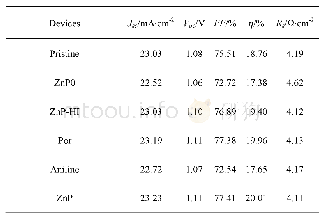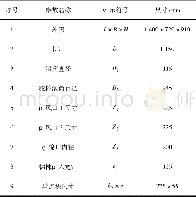《Table 1 Photovoltaic parameters of the devices at the starting point in near space (35 km above the
 提示:宽带有限、当前游客访问压缩模式
提示:宽带有限、当前游客访问压缩模式
本系列图表出处文件名:随高清版一同展现
《Mixed-cation perovskite solar cells in space》
Figure 2(a-i)shows the temperature variation of the devices in near space(35 km above the Earth).The temperature continuously increased from 1.9°C to 69.6°C during the level flight owing to the strong solar radiation and little heat convection in near space.The corresponding real-time light intensity is shown in Figure 2(a-ii).Further,the fluctuations in temperature and light intensity can be explained by the rotation of the pod,which alters the angle of the Sun striking the platform.We mainly discuss the performance of devices under stable irradiation during the level flight.As the starting point,we chose the time at which the light intensity up to136.7 mW cm-2,corresponding to temperature at 26.7°C.The photovoltaic parameters of the devices at the starting point are presented in Table 1.Further,the intensive solar radiation in near pace,especially UV radiation,affects the materials in solar cells[15].To investigate the variation in the device performance,we covered the devices with polyimide(PI)filter and measured the transmittance spectrum of the FTO substrate.The spectra of the FTO substrates with or w/o PI are depicted in Figure 2(b).After covering with PI,the transmittance of the FTO substrate was observed to reduce between 300 and 570 nm.Specifically,the transmittance reduced from 82%to 22%at~430 nm.The difference between the transmittance spectra confirms that the PI filtered majority of the UV radiation.
| 图表编号 | XD0052898400 严禁用于非法目的 |
|---|---|
| 绘制时间 | 2019.07.01 |
| 作者 | YongGuang Tu、GuoNing Xu、XiaoYu Yang、YiFei Zhang、ZhaoJie Li、Rui Su、DeYing Luo、WenQiang Yang、Ying Miao、Rong Cai、LuHua Jiang、XiaoWei Du、YanChu Yang、QianShi Liu、Yang Gao、Shuai Zhao、Wei Huang、QiHuang Gong、Rui Zhu |
| 绘制单位 | State Key Laboratory for Artificial Microstructure and Mesoscopic Physics, Department of Physics, Peking University、Academy of Opto-Electronics, Chinese Academy of Sciences、State Key Laboratory for Artificial Microstructure and Mesoscopic Physics, Departm |
| 更多格式 | 高清、无水印(增值服务) |
查看“Table 1 Photovoltaic parameters of the devices at the starting point in near space (35 km above the Earth)”的人还看了
-

- Table S7.Photovoltaic parameters of mesoporous PSCs based on blade-coating perovskite with the 0.05%zinc porphyrin witho





